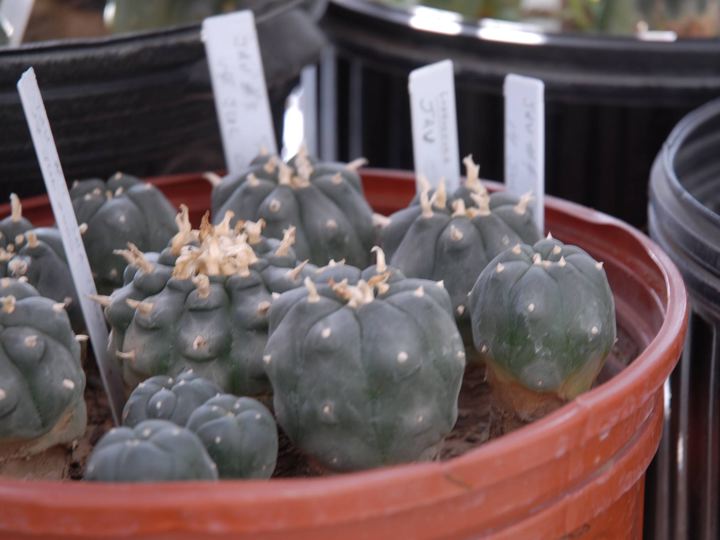
Typical Lophophora williamsii (peyote) in habitat in Starr County, Texas. The U.S. 25-cent coin provides scale. These are not large plants, and are almost certainly regrowth from previous harvest(s).

Typical Lophophora williamsii var. echinata (peyote) in habitat in central Coahuila (near Cuatrocienegas). These plants, strikingly different from the South Texas plants, are similar to the plants in the populations of West Texas.

A dried peyote button, approximately 2 cm in diameter.
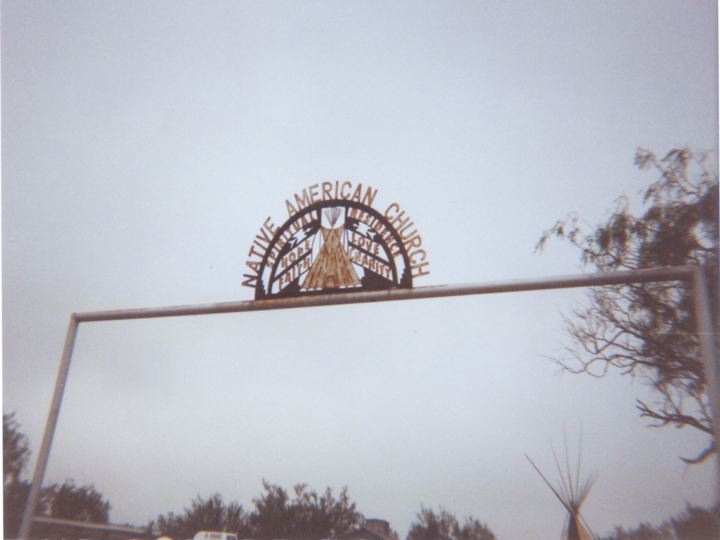
Gate to Native American Church Spiritual Residence in Mirando City, Texas. Note top of tipi in lower right.
The Problems of Diminishing Returns
NAC membership: Unknown.
250,000-400,000 members?
Demand for peyote exceeds the supply.
Demand appears to be increasing while the supply is decreasing.
In Texas, peyote occurs only on the periphery, along the Mexican border.
Commercially harvestable quantities occur only in four counties: Starr, Zapata, Webb and Jim Hogg.
This small area of habitat in the South Texas borderlands supplies the peyote needs of the NAC across the entire continental United States and Canada.
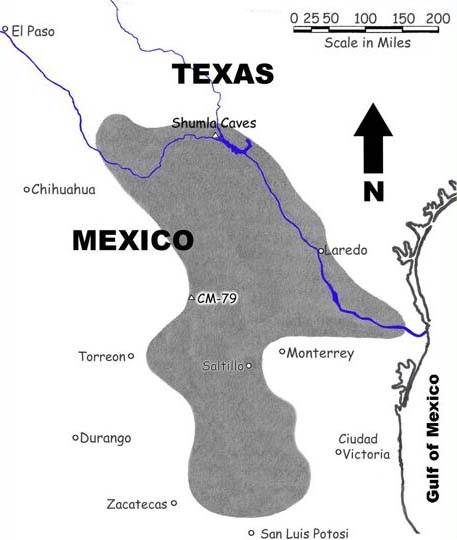
Distribution of Lophophora williamsii. Shaded area corresponds to the area outside of which peyote is not known to occur naturally. The actual distribution within the shaded area is extremely patchy.
The Problems of Diminishing Returns
The DEA-registered distributors of peyote are under pressure to harvest as much peyote as possible to satisfy their NAC customers.
The result is that the distributors return to harvest previously harvested populations too soon – before the newly regenerated buttons are mature.
The results of harvesting too frequently:
(1) Average size of harvested buttons decreases, which results in consumption of greater numbers of buttons to achieve the desired psychic effect. (Vicious circle.)
(2) Seed production of plant population decreases, so that harvested plants are not sufficiently replaced by seedlings.
(3) Some harvested plants never grow back. (Harvest-related mortality.)

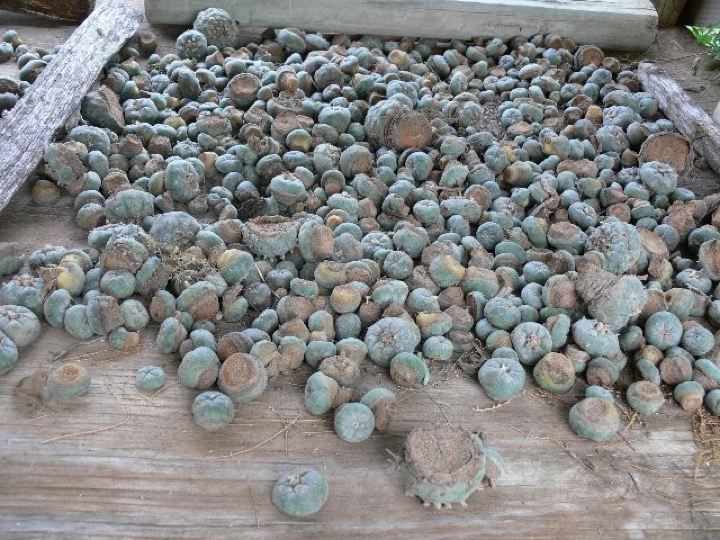
Freshly cut peyote buttons in a bin of one DEA-registered peyote distributor in South Texas. Notice the small size of the majority of the buttons being offered for sale to the Native American Church as religious sacrament. Many are only 1-2 cm in diameter. Photo © 2007 by Gerhard Koehres
Peyote Scarcity is Not Geographically Ubiquitous
Many ranchers exclude peyote harvesters from their ranches and actively protect their peyote populations from poachers.
Where peyote is protected from harvesting, the populations are healthy.
But this fact does not help the NAC or the peyote distributors.
Possible Solutions
Importation of peyote from Mexico
(1) Not a sustainable solution.
(2) Would merely extend the problem of overharvesting from Texas into Mexico.
(3) Mexico has its own problem of scarcity of peyote due to overharvesting in certain regions, as well as its own indigenous peoples who require peyote for ceremonial use.
(4) “Protección especial”: To date, the Mexican authorities have shown no interest in allowing exportation of Mexican peyote to the U.S.
Better harvesting techniques through education.
(1) Most harvesting by DEA-registered peyote distributors and their usual employees is performed correctly and sustainably (cutting the button off at ground level to promote regrowth).
(2) Some harvesters cut too deep on the underground part of the stem or into the root, rendering regrowth unlikely or impossible.
(3) Others are digging up entire plants by the roots, eliminating any possibility of regrowth.
(4) Behavior modification is a long-term process.
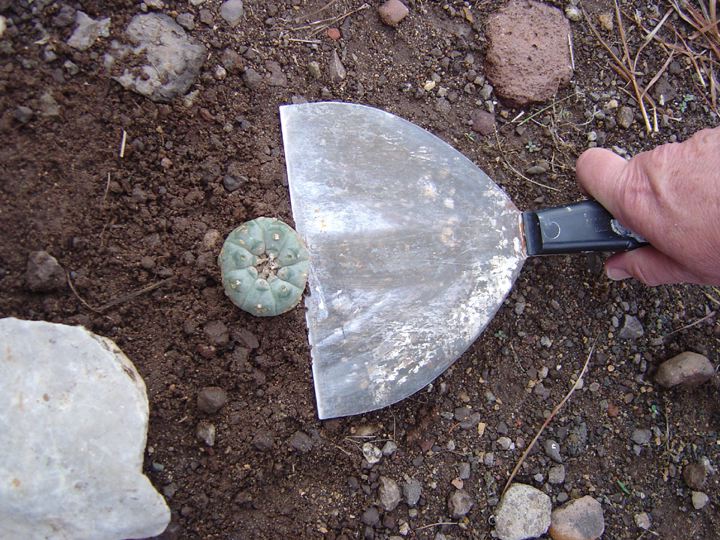
Recommended technique for sustainable harvest of peyote button. The cut is made at ground level and parallel to the surface of the ground. Unfortunately, this procedure is not universally followed in practice, which may result in decreased regrowth. This means increased mortality in harvested plants.
Possible Solutions
Greenhouse cultivation of peyote.
(1) Requires regulatory guidance from DEA, which means creating new policy. At least one petition for greenhouse cultivation by a Native American Church is currently under consideration by DEA.
(2) Requires acquisition of a greenhouse and following a learning curve to optimize greenhouse horticultural production.
Increasing peyote yield in natural habitat.
(3) Requires no huge investment in land.
(4) Security in a greenhouse is easier to maintain than security on rural land in South Texas.
(5) Can be done at any latitude and in any climate.
Greenhouse cultivation of peyote.
(6) Would provide NAC groups with the opportunity to supply their own sacrament using techniques that they themselves determine to be in harmony with their religious requirements for their sacrament.
(7) Would make the self-providers independent of the currently permitted sources of peyote that are limited to South Texas.
(8) Would reduce the harvesting pressure on the wild populations of South Texas, allowing the remaining ones to recover.

A research greenhouse, registered with the DEA, where peyote has been cultivated since 2003.
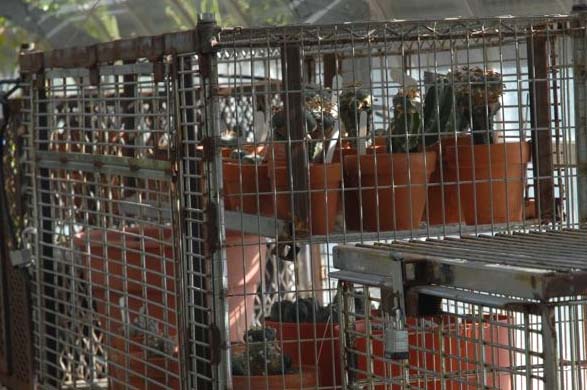
Welded steel cages with padlocks contain the peyote, to prevent “diversion”.
